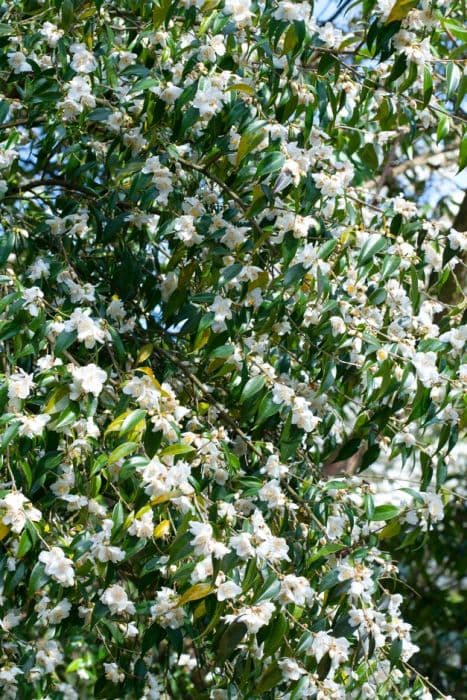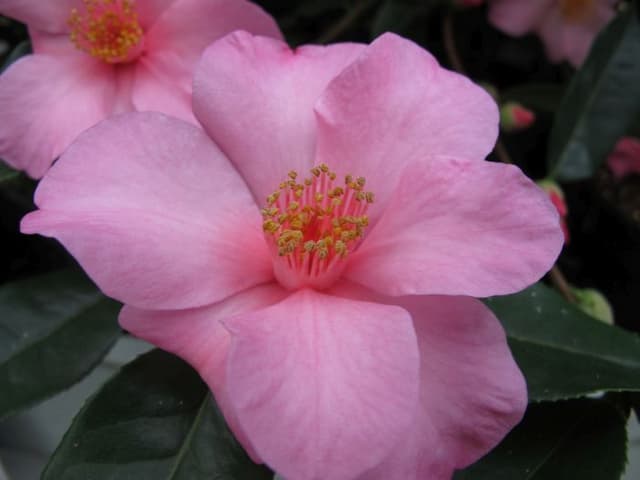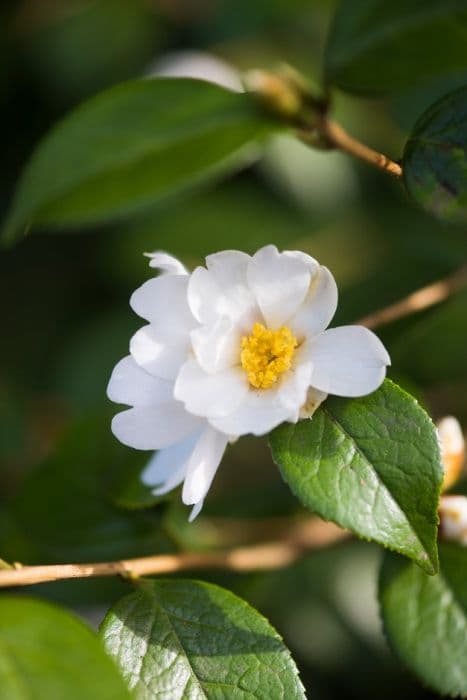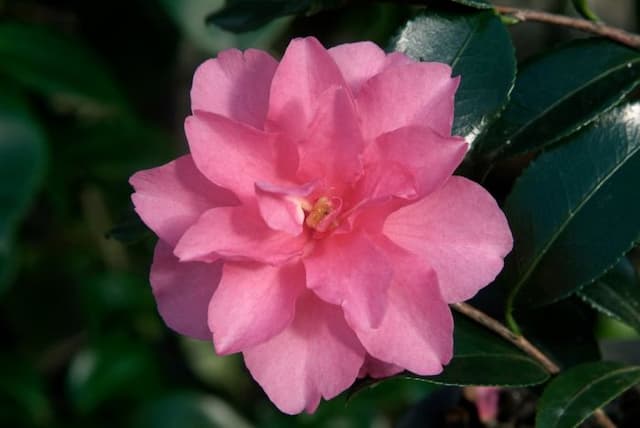Korean cuspidata camellia Camellia cuspidata

ABOUT
Camellia cuspidata, commonly known simply as Camellia, is a species renowned for its striking flowers and lustrous foliage. The plant bears glossy, dark green leaves that are oval-shaped with slightly serrated edges, contributing to its dense and rich appearance. These leaves often serve as a beautiful backdrop for the Camellia's exceptional blooms. The flowers of Camellia cuspidata are its most distinguishing feature, captivating onlookers with their delicate beauty. Each blossom typically exhibits a layer of outer petals that enfold the inner petals creating an alluring and intricate floral display. The inner petals surround a cluster of prominent stamens at the center. The blooms can come in a palette of colors, usually ranging from pure whites to various shades of pink, and even into deeper red hues. The overall impression of Camellia cuspidata is one of refined elegance, with striking blooms that are often associated with grace and perfection in flower form. The plant exudes an ornamental quality that makes it a prized specimen in gardens where its beautiful foliage, and stunning flowers provide visual interest throughout the blooming season.
About this plant
 Names
NamesFamily
Theaceae
Synonyms
Korean Mountain Camellia, Korean Camellia
Common names
Camellia cuspidata.
 Toxicity
ToxicityTo humans
Camellia cuspidata, commonly known as the wild tea plant, is not widely recognized for having harmful effects on humans. There is limited information on its toxicity when ingested. However, it is always advisable to exercise caution and avoid consuming plants that are not typically recognized as food sources. Ingesting unknown plant parts may pose a risk of gastrointestinal discomfort or other adverse reactions in some individuals.
To pets
The wild tea plant, commonly referred to as Camellia cuspidata, does not have a well-documented history of toxicity in pets. However, as with any non-food plant, ingestion by pets should be avoided. While it is not known to be highly toxic, consumption of plant parts by pets could potentially lead to mild gastrointestinal upset or other non-specific symptoms. Always keep houseplants and garden plants out of reach of pets to prevent any accidental ingestion.
 Characteristics
CharacteristicsLife cycle
Perennials
Foliage type
Evergreen
Color of leaves
Dark green
Flower color
White
Height
6-10 feet (1.8-3 meters)
Spread
3-6 feet (0.9-1.8 meters)
Plant type
Shrub
Hardiness zones
7
Native area
China
Benefits
 General Benefits
General Benefits- Aesthetic Appeal: Camellia cuspidata, commonly known as Korean camellia, adds ornamental value to gardens with its beautiful blooms and glossy evergreen foliage.
- Habitat Support: The plant provides shelter and habitat for various species of birds and insects, contributing to local biodiversity.
- Landscape Versatility: Korean camellia can be used in a variety of landscape applications such as hedges, screens, foundation plantings, or as a specimen plant.
- Shade Tolerance: This camellia species can tolerate partial shade, making it suitable for planting under taller trees or in less sunny areas of a garden.
- Seasonal Interest: The Korean camellia typically flowers in late winter to early spring, providing color and interest during a time when few other plants are in bloom.
- Drought Resistance: Once established, Camellia cuspidata is relatively tolerant of drought, reducing the need for frequent watering.
- Soil Adaptability: It can adapt to a range of soil types, though it prefers well-drained, acidic soil, making it a flexible choice for different garden settings.
- Minimal Pests and Diseases: Korean camellia is generally resistant to many pests and diseases, minimizing the need for chemical treatments.
 Medical Properties
Medical Properties- Anti-inflammatory: Compounds in Camellia cuspidata may have the ability to reduce inflammation.
- Antioxidant: The plant contains antioxidants that help in protecting cells from damage caused by free radicals.
- Hepatoprotective: There is evidence to suggest that Camellia cuspidata could offer some protection to the liver.
 Air-purifying Qualities
Air-purifying QualitiesThis plant is not specifically known for air purifying qualities.
 Other Uses
Other Uses- Ornamental purposes: Camellia cuspidata can be grown for its attractive flowers and foliage, making it a popular choice for decorative gardens and landscaping projects.
- Bonsai cultivation: Due to its aesthetic appeal and ability to be pruned and shaped, it is sometimes used for creating bonsai miniature trees.
- Erosion control: The plant's root system may help stabilize soil on slopes and prevent erosion in certain landscapes.
- Hedge or privacy screen: It can be planted in a row to form a dense hedge or living privacy screen in residential areas.
- Cut flowers: Its flowers may be used in floral arrangements and bouquets, providing an elegant and long-lasting option.
- Tea ceremonies: In some cultures, it might be incorporated into tea ceremonies for its ornamental value and serene presence.
- Education: Educational institutions might use Camellia cuspidata to teach horticulture, botany, or conservation principles.
- Photography: The plant's distinctive flowers and foliage make it a subject for nature and botanical photographers.
- Income generation: In some regions, cultivating Camellia cuspidata could be a source of income through the sale of plants or seeds.
- Art inspiration: Artists may be inspired by the plant's beauty to create paintings, illustrations, or other forms of artwork.
Interesting Facts
 Feng Shui
Feng ShuiThe Camellia is not used in Feng Shui practice.
 Zodiac Sign Compitability
Zodiac Sign CompitabilityThe Camellia is not used in astrology practice.
 Plant Symbolism
Plant Symbolism- Adoration and Devotion: Camellias, in general, represent deep love and devotion. The Camellia cuspidata, sharing attributes with its family, is often associated with sentiments of adoration towards someone.
- Perfection and Excellence: The flawless form of the camellia bloom is often symbolic of perfection and striving for excellence.
- Longevity and Faithfulness: The longevity of the camellia flower's bloom, through different seasons, represents the endurance of love and can symbolize the faithfulness in a relationship.
- Admiration: Camellias are also given as a gesture of admiration, possibly due to their beauty and the variety of vibrant colors.
 Water
WaterThe Korean camellia should be watered to maintain evenly moist soil, without becoming waterlogged. Typically, watering once a week with about 1.5 gallons of water is sufficient, but this frequency may need to increase during hot, dry periods or decrease during cooler, wetter periods. Always check the top inch of the soil for dryness before watering. Avoid overhead watering to minimize leaf moisture, which can lead to fungal diseases. It's important to provide deep watering that reaches the roots rather than frequent shallow sprinkles.
 Light
LightThe Korean camellia thrives best in partial shade where it can be protected from the hot afternoon sun. A spot that provides morning sunlight with dappled shade in the afternoon is ideal. Ensuring good light conditions helps the plant produce abundant blooms and maintain healthy foliage.
 Temperature
TemperatureKorean camellias prefer temperate climates and can tolerate a temperature range from 20°F to 85°F. The ideal temperature for growing Korean camellias is between 60°F and 70°F. Protect them from extreme cold, as temperatures below 20°F may damage the plant.
 Pruning
PruningPrune Korean camellias to maintain shape and encourage vigorous growth, by removing any dead or damaged wood and thinning out crowded branches. The best time to prune is just after the blooms have faded in late winter or early spring. Pruning at this time allows for minimal disruption to the blooming cycle, as camellias set their buds in the previous season.
 Cleaning
CleaningAs needed
 Soil
SoilCamellia cuspidata, commonly known as the Korean camellia, thrives best in slightly acidic soil with a pH range of 5.5 to 6.5. The ideal soil mix should be rich, well-draining, and contain organic matter like peat moss, pine bark, and perlite to provide aeration and retain moisture evenly. Amending the soil with compost also encourages healthy growth.
 Repotting
RepottingThe Korean camellia should be repotted every two to three years to refresh the soil and allow for root growth. Once the plant is mature, repotting can occur less frequently, only when the roots fill the pot, typically observed through slowed growth or roots extending out of the drainage holes.
 Humidity & Misting
Humidity & MistingCamellia cuspidata prefers a moderate to high humidity level, ideally around 40-60%. This mimics their natural humid woodland habitat and helps to keep the foliage healthy and encourages robust flowering. Regular misting or a nearby humidifier can help maintain appropriate humidity levels.
 Suitable locations
Suitable locationsIndoor
Place the Korean camellia in bright, indirect light and maintain high humidity.
Outdoor
Plant the Korean camellia in partial shade with shelter from strong winds.
Hardiness zone
7-9 USDA
 Life cycle
Life cycleCamellia cuspidata, known as the wild tea plant, begins its life cycle as a seed which, once germinated in favorable conditions of moisture and temperature, sprouts into a seedling. The seedling stage is characterized by the emergence of the first set of true leaves. As it enters the vegetative growth stage, the plant develops a more robust root system and fuller foliage. During this phase, the wild tea plant requires proper sunlight, water, and soil nutrients to reach maturity. Once mature, it produces flowers that, when pollinated, set seeds to begin the next generation. Finally, the plant may enter a period of dormancy in colder climates, slowing growth before the cycle starts anew with the next growing season.
 Propogation
PropogationPropogation time
Spring-Early Summer
For Camellia cuspidata, commonly known as "Korean Camellia," the most popular method of propagation is by semi-hardwood cuttings. This technique is best carried out in late summer. The process involves selecting healthy, current year's growth that has begun to mature but is not yet fully hardened. Cuttings should be about 4 to 6 inches (10 to 15 centimeters) long, and the lower leaves should be removed. The cut end of the cutting is then dipped into a rooting hormone to encourage root development and planted in a well-draining potting mix. The cuttings should be kept in a humid environment with indirect light until they root, which typically takes several weeks. Once rooted, the new plants can be transferred to individual pots to grow on before being planted out.









